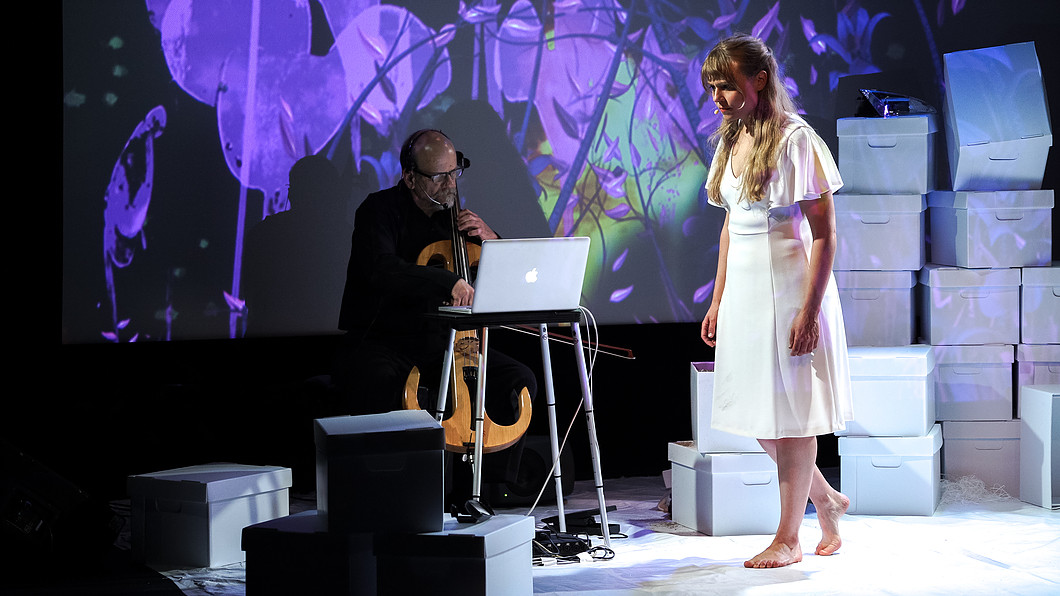Electronic Monodrama, Backwards from Winter, Premieres in New York and Australia
Backwards from Winter starring Anke Briegel in the New York premiere \ Credit: Lucas Godlewski
Backwards from Winter is a new multimedia (video/electronic music) monodrama for soprano, electric cello, computer music, and video—a collaboration between librettist Juanita Rockwell and composer Douglas Knehans. The work has two premieres, New York and Australia, featuring separate productions and casts.
The Stage
The theatrical experience is stark, bold, and immersive wrapped in music that is completely electronic (both "live" and pre-recorded electronic music—not just electronic sounds). It tells a story of love and loss, though in a way that constantly asks questions rather than gives answers. It follows the inception and ultimate tragic demise of a relationship but told in a reverse chronology and linked to a reverse cycling of the seasons, hence Backwards from Winter.
Each season is linked with a key relationship event and a color for that season associated with the event.
Winter/white/grief
Autumn/red/death
Summer/green/love
Spring/blue/anticipation
A stark, dramatic Noh-like approach to stage will be used. This element will also permeate the symbiotic lighting, set design, and video creation to evoke the external natural world that stands as a counterpoint to rich internal questions asked by the protagonist and the music.
Finally, video is a central focus for the bold, colorful Noh-like conception of the form. The projection of video to deftly shifting layered fabric draped dramatically across the tough, inelegant performance space enhances the idea of the eternal ephemeral—the ever escaping and unalterable nature of love and self and their unfocussed contexts: formation, maturation, and loss.
Backwards from Winter \ Credit: Lucas Godlewski
The Libretto
The poetry for each scene of the libretto is formed in three Tanka verses—a Japanese precursor to Haiku—with a syllabic structure of 5-7-5-7-7. This form is used in each scene and was the strict structure we imposed on the literary conception of the work. Each scene is linked by a further Tanka to the next scene so the whole monodrama has a 3-1-3-1-3-1-3-1 structure with the very last sole Tanka acting as a postlude.
The Music
The music was conceived in a similarly strict fashion using only the resources of electric cello, electronically processed soprano voice, and computerized sound. The cellist will also sing, hum, and intone words lending an extra layer of dramatic friction to the music, as does audio filtering and/or processing of the soprano voice. Added to this is surround diffusion of the computerized sounds such that musical ideas can be cast back and forth between corners of the theater lending a spatial motion to the music and providing a fluidly-changing sonic backdrop to live musicians.
Backwards from Winter \ Credit: Lucas Godlewski
The Premieres
The New York City premiere occurred on May 25, 2018 at Symphony Space under the auspices of the Center for Contemporary Opera.
The Australian premiere occurs June 20-23, 2018 under the auspices of Foundation IHOS Amsterdam and is led by composer Konstantine Koukias who is also a visionary stage director who has worked extensively in the combination of traditional theatrical resources with unique lighting, video and electronic sound diffusion in fresh, dramatic, non-traditional spaces. IHOS will be producing the Australian premiere of the work in a new production developed in Amsterdam. Watch this beautiful sample of IHOS’ work.
Mr. Koukias will mount the work for the Dark MOFO Festival of innovative art, music, and performance in Hobart, Tasmania.
His vision of a vast warehouse space and masses of draped fabric as “screens” for the video will create a superbly focused, yet nuanced and layered, backdrop for the video projections that will play a central role in the work. Mr. Koukias has sourced a remarkable team of artists for this Australian premiere.
A scene from the Australian premiere of Backwards from Winter
Douglas Knehans is an EMMY-nominated composer and has written music also for an independent film that has been invited to the Un Certain Regard section of the Cannes Film Festival. He has a deep sympathy with video/film imagery and its coordination and synthesis with music.
Backwards from Winter brings together four important histories of his compositional practice—working with film, with opera, with electric cello and with voice—and represents an important artistic synthesis and new development in his compositional practice and artistic maturation.




